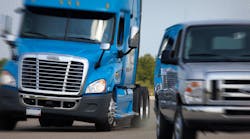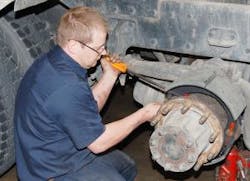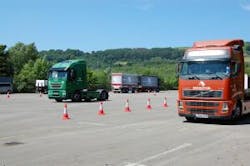Class 8 tractors are stopping quicker than ever today thanks to more powerful braking systems. Back in 2009, the National Highway Traffic Safety Administration (NHTSA) established rules to significantly cut stopping distance requirements for tractors. From the perspective of brake system makers, the majority of tractors operating on U.S. roads—mainly those with tandem rear axles, which account for 60% to 70% of the highway rig population—successfully complied with the new stopping distance using nothing more exotic than wider “enhanced S-cam” 16.5-in. drum brakes.
The larger size and design refinements of these brakes dissipate heat more effectively and as a result, stop trucks within a significantly shorter distance than their predecessors.
“Four years ago, there was a big gap in performance between drum and air disc brakes (ADBs),” notes Joseph Kay, director of brake engineering-North America for Meritor Wabco. “With the regulatory changes driving design improvements, we’ve significantly narrowed that gap to where there’s now very similar performance between the two.”
The rules that brake manufacturers are meeting vary based on the type of vehicle. They are:
- A typical three-axle tandem tractor with a gross vehicle weight rating (GVWR) of 59,600 lbs. or less coupled to a trailer and traveling at 60 mph must come to a complete stop in 250 ft., compared to the former 355 ft. stopping standard. This reduced tractor-trailer stopping distance roughly 30%.
- For heavy, severe-service tractors with GVWs above 70,000 lbs., the stopping-distance requirement is reduced to 310 ft. at the same speed. The caveat is that all “heavy truck tractors” must stop within 235 ft. when loaded to what is termed their “lightly loaded vehicle weight.”
- Two-axle (4×2) tractors and tractors with a GVWR above 59,600 lbs. (6×4) must also meet the 250 ft. at 60 mph rule. So-called “heavy, severe-service tractors” sporting GVWs above 70,000 lbs. are required to meet the shorter stopping distance of 310 ft.
Yet Kay stresses that meeting these rules is not the end game for braking system developments on commercial vehicles. “The focus is on ways to help reduce the weight of the braking system not only for fuel efficiency, but to carry more revenue-generating freight as well,” he explains. “This is something we’re really listening to and we’ve got a lot in the research and development pipeline to address this need, especially where foundation or drum brakes are concerned.”
He says engineers worked for years to optimize the cost of S-cam or drum brakes, but not in terms of weight. “It’s a mature technology that we’re now taking a fresh look at,” Kay points out. In his estimation, about 100 lbs. of possible weight savings are within reach.
“One side effect, of course, of such weight reduction is that price will go up,” he cautions. “But we’re trying to balance that final value against the savings less weight will provide. In essence, we’re weighing the value of total cost of operation (TCO) savings over the life of the vehicle against initial purchase price changes.”
Friction rising
John Thompson, sales manager for TMD Friction, notes that the reduced stopping distance, or RSD, requirements called for larger front brake size and power, meaning changes needed to be made to drum brake basics.
Their size went from a diameter of 15 in. to 16.5 in., with drum brake shoe width increasing from 4 in. to 5 in. and even 6 in. in some cases. On top of that, brake power went from type 20 air chambers to type 24, he says, while also stressing that all of those changes alone were not enough to produce the torque required for shorter stopping distances.
“The friction level of steer axle drum brake linings increased significantly,” Thompson points out. “Drive axle friction levels went up, certainly, but nothing like the major changes to the front [steer axle] brakes.” That’s why many truck OEMs now spec ADBs as standard on the steer axles of some vehicles while keeping them optional on all others.
“ADB installations will continue to grow moving forward,” he adds. “While there is still a cost penalty up front, the stopping ability and feel is very solid. Well-maintained ADBs can last much longer than drum brakes before their first reline. And the first pad change can be performed in much less time than the equivalent drum brakes as long as rotor replacement is not required.”
Yet it is the friction material within the brake that is garnering a lot of engineering attention these days as more friction is being generated by the more powerful braking systems. Several ripple effects can come into play when higher levels of friction are generated, notes Gary Ganaway, director for drum brakes, marketing, and global development at Bendix Spicer Foundation Brake. These include a higher occurrence of noise and vibration along with shorter maintenance intervals.
“Friction materials not only need to meet the [stopping distance] performance standards, they’ve got to offer longer life as well,” he explains. “From surveys of our customer fleets, we find that the desire on the part of long-haul operators with five-year [truck] trade cycles is to get through 500,000 mi. without replacing brake linings or pads. Yet on the regional carrier side, where many want to keep trucks for 10 to 12 years, that’s where TCO comes more strongly into play.”
Ganaway points out that not only must brake makers figure out a way to meet such lifecycle demands along with “softer” needs such as less noise and vibration, they’ve got to do it in a higher brake torque environment where brake torque is not constant.
“The rule of thumb is a panic stop, if you will, equals about 80 psi (pounds per square inch) of braking force,” he says. “But 90% of the time, trucks are using 20 psi or less worth of stopping power moving through city streets, on the highway, etc. The challenge, then, is how to satisfy two very different levels of force at the extreme ends of the [brake usage] scale.”
Braking balance
Jim Reis, vice president and general manager of the brake products division at Stemco, echoes that assessment. “New [friction] materials often aren’t matched for everyday normal driving conditions where brake line pressure is typically 20 psi or less,” he explains. “While fleet experiences differ, there are reports of steer axle friction requiring more frequent replacement due to premature wear or undesirable noise, vibration or harshness.”
Tractor-trailer brake balance is also becoming more of a concern, Reis adds, as RSD-compliant tractors with beefed up S-cam drum brakes or ADBs may provide greater braking power than the trailer they are towing. This results in additional tractor brake wear and possibly unstable vehicle dynamics in an emergency situation.
Bendix’s Ganaway notes that tractor-trailer imbalance is also a reflection of the braking dynamics that come into play in the commercial vehicle arena. “The [braking] load is most pronounced on the steer axle, followed by the drive and then trailer axles,” he says. “That load shifting from rear to front means the needs and forces at play on trailer brakes is very different from those on the tractor.” Not to mention that the drum brakes typically used on trailers are far smaller in width compared to the beefed up drum units now being used on tractors.
TMD’s Thompson says one way to compensate for all of that is to use what he dubs a “balanced friction formula.”
“[Drum brake] lining manufacturers have taken different approaches for dealing with increasing brake torque,” he explains. “Some have moved to semi-metallic formulas, which offer higher torque but usually result in lower drum life and a higher propensity for noise. They are also more expensive.”
Also available are what he calls “organic materials” with high friction on both the cam and anchor blocks.
“A third alternative is a high friction organic cam block and a lower friction organic anchor block,” Thompson notes. “This is done to reduce the propensity for noise without sacrificing performance.”
There’s also a fourth alternative and that is a semi-metallic cam block with a lower-friction organic anchor. “This reduces the cost over straight semi-metallic and reduces the noise propensity but is still generally higher-wearing than organic,” he explains.
ADB pads have higher friction options as well and generally give superior stopping power over drum brakes, Thompson points out, with ADBs offering much less fade than drum brakes. “There is much less propensity for brake pull due to brake geometry inherent in the [ADB] design,” he explains.
Longer term, though, one big challenge on the horizon for friction manufacturers is the reduction of copper to ultimately less than 0.5%—part of what’s being called the “Better Brake Rule” being established in California and the state of Washington, Stemco’s Reid says.
“That rule progressively limits potentially hazardous materials such as asbestos, lead, cadmium, mercury, chromium, and copper, among others, from friction materials sold in those states,” he points out. “Other states are expected to follow the Better Brake Rule in the near future.”
“While there is minimum impact on drum brake lining [from this rule], many disc pad materials do not currently meet this standard,” TMD’s Thompson stresses. “The change in regulation is less than 5% by 2021 and less than 0.5% by 2023, but manufacturers are actively pursuing solutions now. This project will result in new materials and processes to meet that regulation.”
Electronics ahead
Brent Fitch, director of fleet sales for Wabco, points out that the elimination of the torque plate is the next big engineering challenge for ADBs, as that will generate weight and cost savings. “We also believe that in the coming decade, electronically controlled brakes will be the next major advancement in brake technology,” he says.
“Electronic braking is growing and will likely dominate in the near future,” Thompson says. “Air systems are still required, but the signal to the wheel end is by electronic signal instead of air. This will shave time off the system’s reaction between the movement of the brake pedal and actual brake application, meaning a vehicle moving at 60 mph or 88 ft. per second will stop 8 ft. shorter if brake application is reduced by just one-tenth of a second.”
Meritor’s Kay stresses that all such engineering advances must be tailored to specific truck applications. “You’ve got so many different braking configurations across the board in trucking,” he says. “You’ve got different tires, different loads, static versus dynamic loads, and the fact that fleets often operate a multiple of different vehicle types in different settings performing different types of work. All of those variables add up, meaning it’ll take time and research to really get break systems optimized for all those applications.”





